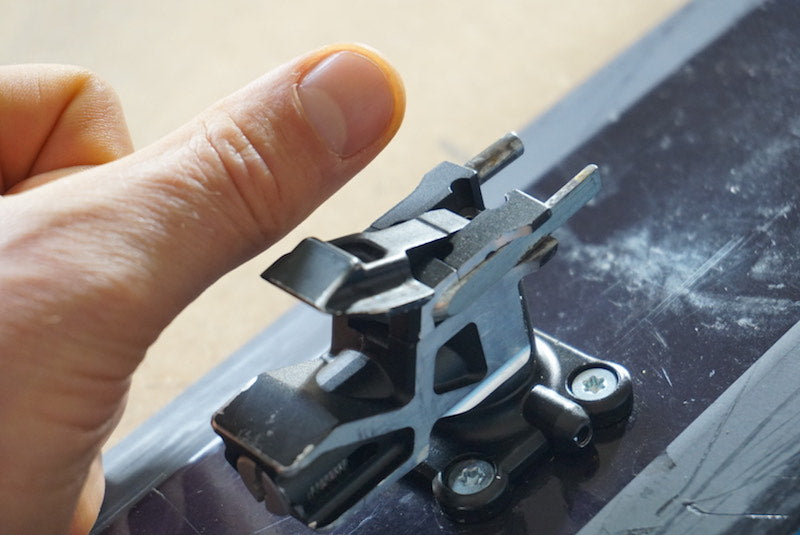IS DYNAFIT’S SUPERLITE 150 THE BEST MINIMALIST PIN BINDING EVER?
Review by Matt Coté
After 15 years of skiing on pins in the backcountry, I’m calling it: Dynafit’s new Superlite 150 is the ultimate lightweight tech clamp.
Now, before I go too far, let’s be clear what category of binding we’re talking about here. While pin bindings are already light bindings, within the pantheon of offerings therein, there are still some notably bulkier and sleeker options. These are the latter: they don’t compare to a Marker Kingpin 13, Duke PT 16, a G3 Ion 12, or even Dynafit’s own Radical 2.0 series. These Superlites are a minimalist binding, weighing in at only 150 grams per side, where any of these others come in between 700 and 800 grams. So even within the pin-binding kingdom, we’re dealing in a different class here.

But, if like me you want a turbo light binding to compensate for running a meatier powder ski, and then can double as an incredibly dependable featherlight setup for sending deep missions in the spring, you’re on the right track here. This is a binding lightweight enough to ski mountaineer in, but also strong enough to slay pillows and fat pow the rest of the season.

Building off the design of the Superlite 2.0, (which is still available), Dynafit’s Superlite 150 sheds 25 grams per ski, and comes made of solid metal for a stronger interface, plus offers a lateral release value all the way up to 13, with four riser modes.

To achieve all this there are some compromises: The first is there’s no adjustment for boot-size length at all—you mount it once for the boot ya got, and that’s that. And, though there are four riser modes, you do have to reach down to toggle between flat mode and any of the others. You can, however, go between medium and high with just your ski pole once the heel is spun (There’s also a race mode where you can use just one riser without ever even spinning the heel). Note that the risers on this binding aren’t as high as those on traditional tech bindings. If you’re climbing skin trails in the Tetons, you might find you don’t get enough out of these to go SFU (straight the f***k up). But if you’re on reasonable skin tracks (you’re likely setting your own if you’re using these), the risers are plenty adequate.

The Superlite 150 uses a U-spring in a very simple metal heel tower, replacing the plastic tower from the Superlite 2.0 with an even smaller one. Some companies claim U-springs wear out your inserts, but for reasons I won’t get into here, this isn’t worth worrying about. Plus your inserts are replaceable in five minutes for under $40. No, the only real downside to U-springs is the fixed/non-adjustable front release value, and the fact that the metal of the spring itself does fatigue over time with every step in and release (just like any spring through the course of its life). But this is negligible. Besides, if you’re maxing out the springs inside your regular tech bindings, I’ve got news for you, the same thing is happening there.

While I have previously had trouble with unwanted forward pre-releases from U-springs, after a solid two months of skiing on these, I haven’t had any issues. Dynafit says the rear forward release is rated somewhere between 9 and 10, but it feels stiffer to me, and has been holding me in great (I usually ski at 11). I’m going to credit that to the all-metal heel tower.

Because there’s no elastic travel/forward pressure or boot-length adjustment (it’s a true low-tech binding), what’s most beautiful here is you’ll never develop any jiggle or play in the binding. It is as rock solid of an interface you could ever have, and you can feel it when you lay the ski over.

But the question remains, how do they ski? Moving from the Superlite 2.0 to the Superlite 150 binding, I find the new 150 has a superior clamp and holds an edge noticeably better. I’ve been skiing the toes unlocked in powder and pillows (though I still have a personal policy of locking any tech toe in steep, icy or chalky conditions), and they’ve been flawless. While the Superlite 2.0’s toe had a tendency to break if you overpowered it in hard conditions, that anxiety is entirely gone with this one. Dynafit widened the mounting pattern, gave it more metal around the screw holes, but shrank the forward length of the binding to save weight (where the torsional forces of both walking and skiing are at their lowest). The flipside is that it does become hard to clear snow from under the toe jaw if it ever ices up, but this has only happened for me while winter camping.

All told, Dynafit has produced the best minimalist pin binding I’ve ever been on with the Superlite 150, and I have a hard time imagining how it could improve from here. Still not sure if this is for you? Here’s a simple question: Are you a modern, ski-mountaineering freerider that doesn’t expect your boot length to change? Get this binding.
MSRP: $599 CAD
Click here for more info.
